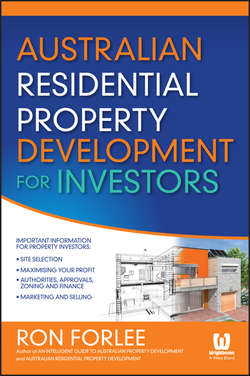Читать книгу Australian Residential Property Development for Investors - Forlee Ron - Страница 12
На сайте Литреса книга снята с продажи.
CHAPTER 1
An overview of property development
Types of commercial developments
ОглавлениеCommercial properties can be categorised into the following areas.
Office buildings
Office buildings are rented to non-retail commercial users. These structures are designed as low-rise, mid-rise or high-rise buildings and can consist of one to 20 stories or more depending on the zoning and density regulations. Users of the office space sell and administrate a service to the public. Offices do not need a retail location and depending on their quality and finishes can be classified as class A, B or C offices. Following are various types of office accommodation:
• renovated house
• strata title offices
• office parks
• multi-storey office blocks.
Retail centres
While individual investors without any particular expertise frequently own small strip shops and neighbourhood shopping centres, more experienced, knowledgeable and financially able investment groups usually undertake investment in larger retail outlets. The bigger retail developments also involve complicated analysis, planning, financing, leasing and management problems. These retail centres include:
• corner-shop convenience store
• strip shopping
• neighbourhood shopping centre (1000m2 − 5000m2)
• district shopping centre (5000m² − 20 000m²)
• regional shopping centre (20 000m² plus)
• hyper-centre (20 000m² plus)
• theme centres (size varies) – these are retail centres designed around a common theme, such as a:
• – discount centre
• – factory outlet centre
• – fashion centre
• – car care centre.
Industrial buildings
Buildings that provide rental space to users of bulk storage are defined as industrial buildings. These buildings are designed for users, requiring a small percentage of office space (10 to 20 per cent) with the balance being large warehouses with loading facilities. Industrial properties are broken down into:
• office–warehouse
• service industrial units
• distribution centres
• bulk distribution
• manufacturing facilities
• storage facilities.
Tourist accommodation
Tourist buildings include varied facilities common to different types of short stay or destinations such as accommodation, restaurants, eateries, entertainment, leisure and relaxation. They can be further defined as:
• hotels
• serviced apartments
• motels
• casinos
• entertainment centres
• resort golf course estates
• marina developments
• waterfront developments
• theme parks
• conference centres.
Educational centres
Educational facilities can vary from private primary schools to tertiary centres such as colleges and universities with adjacent science technology parks. Categories include:
• child-care centres
• primary to high schools
• colleges
• universities
• science and technology parks.
Medical buildings
The development of medical facilities can be lucrative if well-located sites are found. Facilities can vary from small doctor's rooms to operating theatres in larger buildings. The buildings can be categorised into:
• clinics
• suburban medical centres
• neighbourhood medical centres
• private hospitals
• regional hospitals.
Mixed-use developments
A mixed-use development can vary with different asset classes, with a mix of residential and commercial buildings. This type of development is found closer to the central business district or transport nodes.
Niche markets
These specialised developments are not normally available to the average investor or developer and can include:
• petrol outlets
• sports stadiums
• parking lots and garages.
